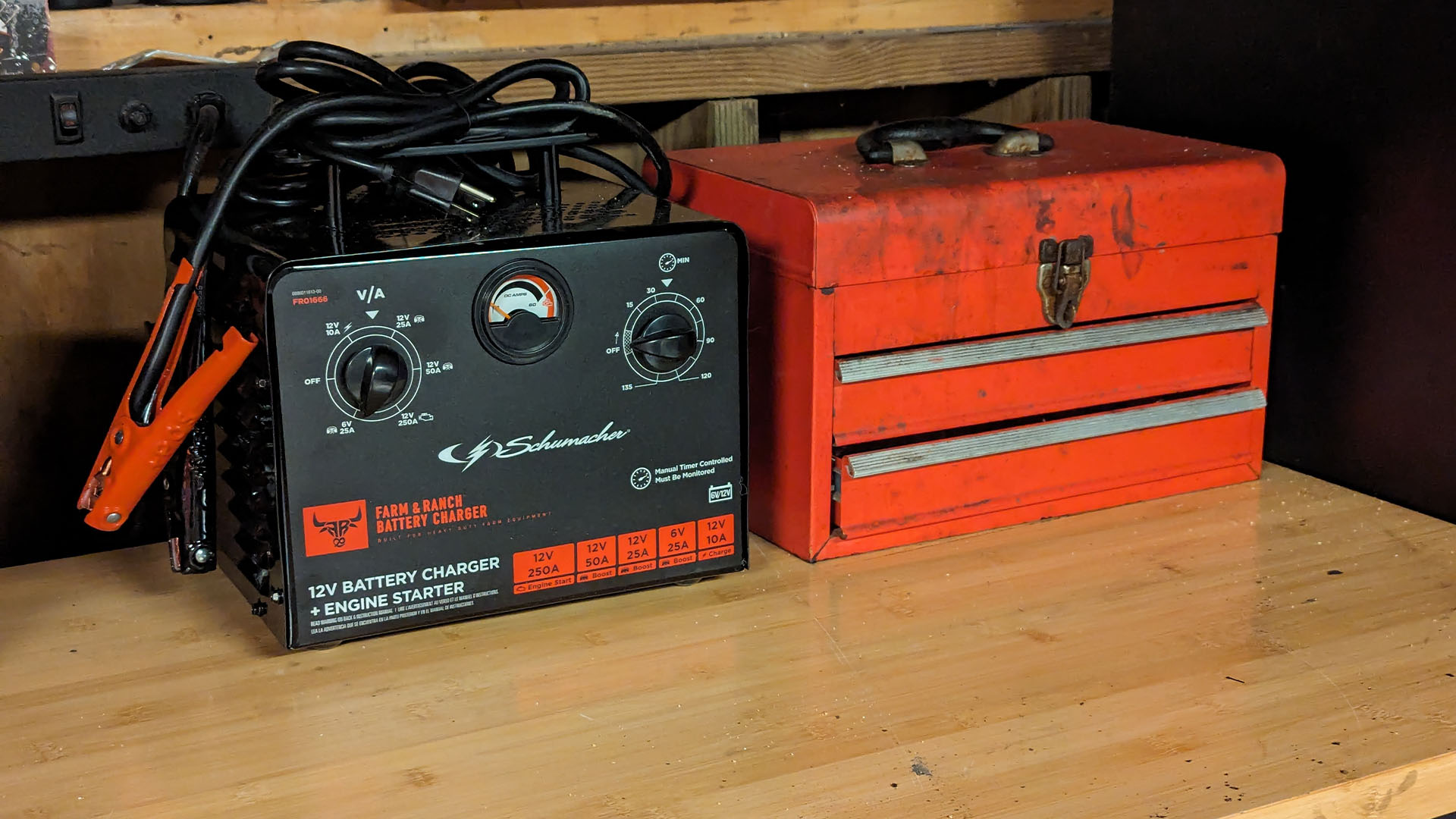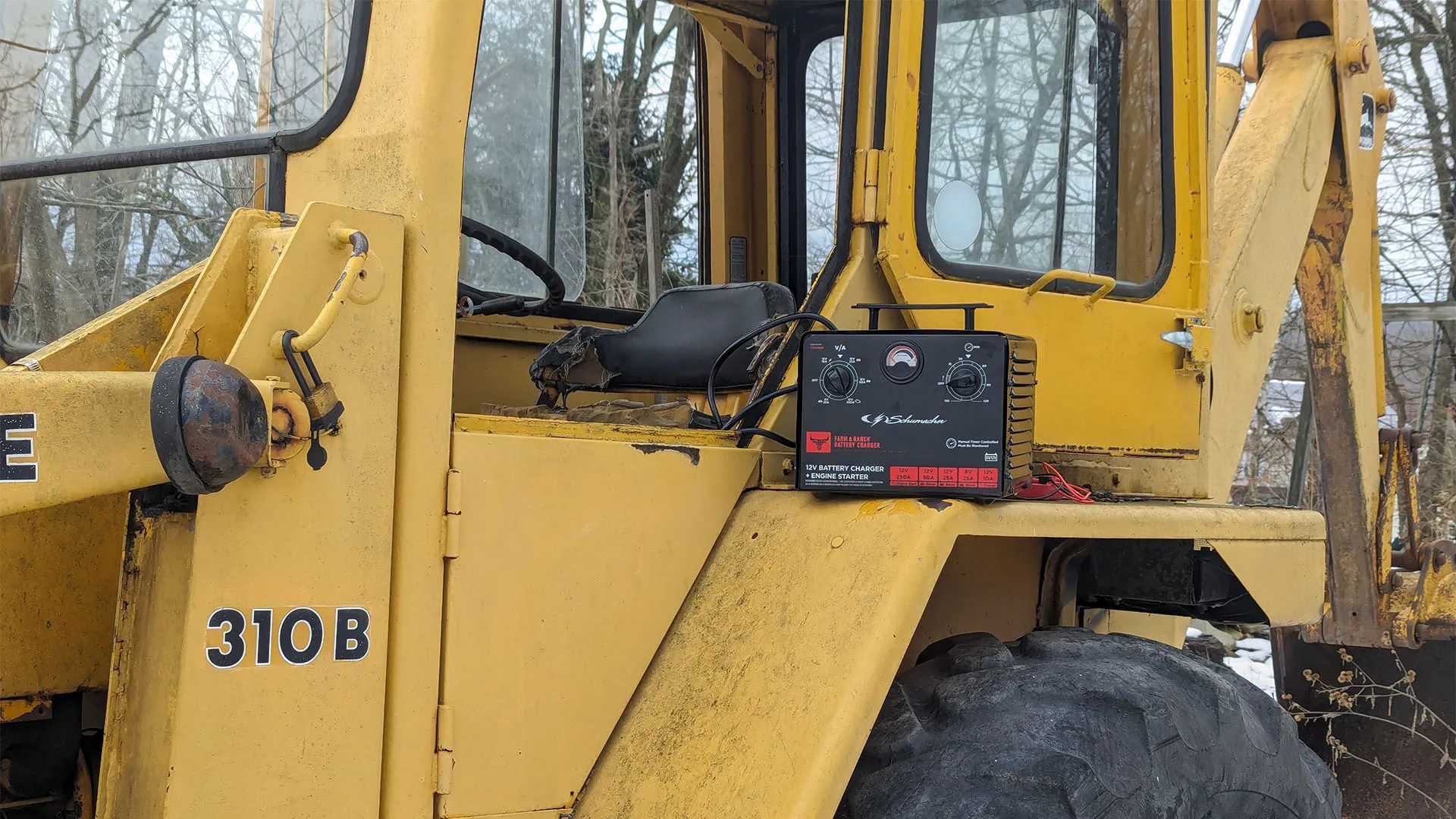

We may earn revenue from the products available on this page and participate in affiliate programs. Learn more ›
Automatic battery chargers can be awesome tools to have in the shop. They take all the guesswork out of making sure your batteries are full of that sweet, sweet juice you need to crank your engine to life. All you have to do is hook up the leads, and let them work their magic for a few hours. Or at least, that’s how it should go.
We’ve all got stories of automatic chargers giving bad readings, failing to charge fast enough, and leaving us dead in the water. That’s why a lot of car owners prefer to stick with manual chargers. Sure, they’re a little more of a pain to set up, but they’re ultra reliable, which is extremely important when it comes to something as critical as topping off your batteries.
Schumacher Electric needs no introduction. It’s an absolute powerhouse in the world of battery chargers, and has been hard at work since 1947. Recently, it introduced the SC1667 and SC1666 250A 6V/12V Manual Timer-Controlled Battery Charger and Jump Starter for folks who like to take matters into their own hands. I just so happen to have one in my possession, and I’m happy to lay out what it brings to the table for anyone considering snagging one for themselves.

Schumacher SC1666/SC1667 Initial Impressions
Schumacher’s new 250A 6V/12V Manual Timer-Controlled Battery Charger and Jump Starter comes in two versions: the standard version, which is part number SC1667, and the Farm and Ranch version under part number SC1666. The only difference between the two is superficial marketing stuff. I was actually sent the ladder as the SC1667 was on backorder at the time. I’m totally cool with that because the sweet logo on this one just makes it feel more official.
These manual chargers have three charge modes, 10 Amp, 20 Amp, and 50-Amp, all of which are controlled by the timer knob, which can be set to run for up to 135 minutes. It can be used on both six and 12-volt lead-acid batteries, including standard, AGM, and Gel types. While that’s generally as good as it gets for many battery chargers, it also has a built-in 250-amp jump starter to help get you up and running in a hurry.
As for physical dimensions, it measures 8.5-inches tall, 10 inches wide, and has a depth of about 9 inches. That’s no compact piece of equipment, but this obviously isn’t built with much portability in mind. Though, it does have a carry handle on top for ease of transportation and power cord and cable leads measuring 6 feet in length are perfectly reasonable for use within the confines of most shops.

This is a manual charger, meaning you need to calculate and physically select your settings, unlike an automatic charger that you simply hook up and forget about. The lack of a digital readout, with dials in their places only emphasizes the nature of this charger. You may be tempted to argue that the readings of the knobs will wear with time, but the use of an extremely tough coating says they’re here for the long run. The same level of quality is shared throughout the charger with a rigid sheet steel housing and its heavy-duty cables. This truly looks and feels like a professional tool despite being listed as a hobby-level charger on Schumacher’s website.
Don’t let manual setup hang you up too much, either. It’s not as complicated as you might think. Determining how to set it up relies on a couple of details and two basic math formulas. The first formula you’ll need is to determine the duty cycle of the battery, which can be found by taking the reserve capacity, dividing it by two, then adding 16.
The second formula is used to determine how long you need to run the charger, which is based on the percentage of charge needed and how many amps you want to charge it with. All of this is broken down neatly for you in the instructions, with the exception of a battery charge percentage chart, but that can be easily pulled up on the internet. Of course, the time it takes to figure all of this out needs to be taken into consideration when comparing charge times against an automatic charger. However, it is something you’ll get really proficient with in time and takes no more than a few minutes to begin with.
Using it Around the Shop
Between what’s in my personal vehicles and the spares I’ve got hanging around the shop, I had plenty of opportunities to see just how well this manual charger works. The first thing I did was compare it to the automatic Battery Tender Junior 800 that I regularly use to keep batteries topped off.
By sheer coincidence, two spare batteries I have sitting here had about the same level of charge and are very similar in size. One group 34 battery with 875 cranking amps, and one group 24 battery with 810 cranking amps, at around an 80 percent charge. While not identical, this was a great chance to see how these compared in terms of speed.
Without a particular bias, I set the Schumacher up to run a 10 AMP charge cycle on the group 24 battery, which, based on my math and its 110 reserve capacity, required an hour and 45-minute charge. I set the Battery Tender up on the group 34 battery, with no math involved.

In this particular test, the Battery Tender reached a full charge about 15 minutes before the Schumacher did. However, had I moved to a higher amperage, the Schumacher would certainly have smoked it. Moving up to a 20-amp charge would have theoretically taken about 53 minutes. It’s a bit of an apples to oranges test, but it still paints the picture as to what this charger brings to the table.
I did have a third battery lying around the shop that was dead flat, showing just around 2 volts. This gave me the chance to see how the Schumacher manual charger did with a deeply discharged battery. For this process, I opted to work cautiously and run several 10-amp charge cycles rather than pumping full juice into it over a short period. It took about 4.5 hours total to complete, but it did bring that dead battery up to a full charge.
Moving to a 20 or even 50-amp charge would have sped things up dramatically. However, I generally never charge batteries that are this dead, as I’m admittedly out of my comfort zone in terms of in-depth battery knowledge, and I’m aware of the potential risks. So, it’s better to work with too much care than too little.
I’m more surprised with the dead battery taking charge than with the Schumacher doing what I told it to. However, this test, to me, showed the strength of tailoring the working process to my needs.

How About the Jump Starter?
A major selling point of this model is that it has a 250-amp jump-starter built into it. This feature will come in handy on many occasions around the garage, but because Schumacher sent me the Farm and Ranch version of this new charger, I knew it was only appropriate to put it to work with a test to match.
My father owns a John Deere 310B Backhoe. It’s been sitting for over a year now, and he’s due to get it running for good exercise. With this being sent for review, it was a good excuse to get after it. This particular backhoe doesn’t have the biggest engine at just 219 cubic inches. However, an inherently high compression ratio and battery charge sitting around 11 volts made for the perfect test.
In all reality, we spent more time running the extension cord up to the machine than we did running it. The second I set it to the jump settings, the tractor roared to life without sitting for so much as a few seconds of lead time. I’m not surprised that it worked, but I am impressed with how quickly it did. I’m used to waiting a minute or two for cordless jump starters to do their thing. This was almost instantaneous, which slightly offset its reliance on a cord. Though, the cord really isn’t that big of a deal for something that’s really designed to be used in a workshop, not out in the field like this.

The Verdict
At the end of the day, this is a well-built piece of equipment that’ll get the job done. It’s not the fanciest or easiest thing to use, but it’s not meant to be. In fact, low frills likely bolster the dependability of this unit, and that’s obviously highly appealing to the audience this model clearly targets.
| Schumacher SC1666/SC1667 Manual Charger and Jump Starter | |
|---|---|
| Value | 8/10 |
| Quality | 9/10 |
| Ease Of Use | 5/10 |
| Durability | 8/10 |
| Overall | 7/10 |
It’ll charge batteries and jump life into them. There’s some math involved, but you’re never left wondering if a computer is functioning the way it should or if indicator lights are telling you the truth. The Schumacher SC1666/SC1667 is going to do exactly what you tell it to and when, and that’s an awesome thing to have in any product.
The size of the unit might be a bit of a concern as it’s far bigger than most digital chargers. However, that’s a small price to pay for something that offers rock-solid dependability. Thankfully, it’s pretty pleasant to look at as well, so at least when you leave it on the workbench, it won’t be an eyesore. Ultimately, it’s hard to argue with the package Schumacher whipped up here, especially for the current $184.16 price at Amazon.